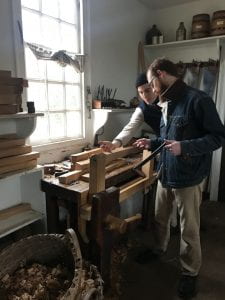Physical Sense in the Wheelwright Shop
By James Kelleher, WPAMC Class of 2020
Our recent trip to Colonial Williamsburg was a rare opportunity to focus in on a variety of craft and manufacturing processes, and to get a taste of what performing these crafts process is actually like through hands-on workshops. There’s a certain type of understanding that can’t be related visually or verbally: it has to be physically experienced. Through their training (and experimentation), craftspeople learn the nuances of this tactile data and how it influences their work. This is true to some degree in all trades, but I was particularly fascinated with how tactility and physical sense were displayed in the wheelwrights’ shop. Wheels, I think, were the most mechanically complex single objects that we saw being made in Williamsburg, and certainly were under the most mechanical strain.
Probably the most surprising thing I learned was that wheels were made dish-shaped to avoid flexing (and eventually breaking) and were mounted on angled axles so that the wheel’s bottom spokes were perpendicular to the ground. There’s a relatively high level of practical physics that a wheelwright needs to understand to grasp why this design works, and why a flat wheel would not.
The dish-shaped wheel works on the same basic principle as a dome. In the latter, downward force on the top of the dome is directed outward, preventing the structure from collapsing. In a dished wheel, the spokes direct the lateral forces on the wheel’s hub outwards towards the rim (reinforced by an iron tire). This prevents lateral movement of the hub within the rim which would make for a pretty uncomfortable carriage ride and ultimately would shake the wheel apart. Wheelwrights understood this long before modern force diagrams and mathematics could tell us exactly why and how this is true. Even if many wheelwrights didn’t understand the reason for making wheels in a certain way (although I suspect most of them did) the apprenticeship system helped assure that the lessons learned through trial and error need not be relearned with every new generation. Learned physical processes both influence and propagate good design.

The author trying his hand shaving a spoke at the bench spike, where his denim jacket served him well as padding.
Fortunately, we were able to participate in the craft process as well as watch. We each took turns using drawknives to shave down wooden blanks into rough spokes. There are two ways to hold the spokes while doing this: the first is a sort of vice that holds the spoke between two spikes, where it can be rotated as needed to shape different faces. The second way involves using one’s hip to press the spoke up against a spike driven into a leg of the workbench. What I found interesting was that one of the apprentices, as well as myself and many of my peers, preferred the bench spike to the vise. Later that evening I spoke with my classmate Emily to try and tease out why we preferred the method that pretty objectively was harder on the body and required more physical labor (or at least dictated a more rigid posture). As near as we can figure, the fact that the bench spike brings the workpiece in contact with the body can be seen as a positive trait- it allows the maker another level of direct tactile feedback from the workpiece, giving them more information on how to proceed. In short, we felt more in contact with, and in control of, the work being done. This is exactly the kind of information that can’t be put into words and can only be hinted at in images. It’s a small example, but one that illustrates the value of tactile experience in understanding craft.


Leave a Reply